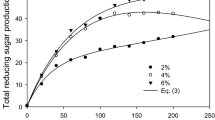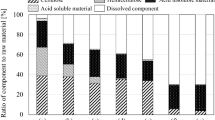Abstract
Alkaline–oxidative (A/O) pretreatment and enzymatic saccharification were optimized for bioethanol fermentation from water hyacinth by Saccharomyces cerevisiae. Water hyacinth was subjected to A/O pretreatment at various NaOH and H2O2 concentrations and reaction temperatures for the optimization of bioethanol fermentation by S. cerevisiae. The most effective condition for A/O pretreatment was 7% (w/v) NaOH at 100 °C and 2% (w/v) H2O2. The carbohydrate content was analyzed after reaction at various enzyme concentrations and enzyme ratios using Celluclast 1.5 L and Viscozyme L to determine the effective conditions for enzymatic saccharification. After ethanol fermentation using S. cerevisiae KCTC 7928, the concentration of glucose, ethanol and glycerol was analyzed by HPLC using a RI detector. The yield of ethanol in batch fermentation was 0.35 g ethanol/g biomass. Continuous fermentation was carried out at a dilution rate of 0.11 (per h) and the ethanol productivity was 0.77 [g/(l h)].





Similar content being viewed by others
References
McKendry P (2002) Energy production from biomass (part 1): overview of biomass. Bioresour Technol 83(1):37–46
Mete Altintas M, Ulgen KO, Kirdar B, Ilsen Onsan Z, Oliver SG (2002) Improvement of ethanol production from starch by recombinant yeast through manipulation of environmental factors. Enzyme Microb Technol 31(5):640–647
Lynd LR, Cushman JH, Nichols RJ, Wyman CE (1991) Fuel ethanol from cellulosic biomass. Science 251(4999):1318–1323
Ingram L, Aldrich H, Borges A, Causey T, Martinez A, Morales F, Saleh A, Underwood S, Yomano L, York S (1999) Enteric bacterial catalysts for fuel ethanol production. Biotechnol Prog 15(5):855–866
Lewandowski I, Scurlock JMO, Lindvall E, Christou M (2003) The development and current status of perennial rhizomatous grasses as energy crops in the US and Europe. Biomass Bioenerg 25(4):335–361
van Maris AJA, Abbott DA, Bellissimi E, van den Brink J, Kuyper M, Luttik MAH, Wisselink HW, Scheffers WA, van Dijken JP, Pronk JT (2006) Alcoholic fermentation of carbon sources in biomass hydrolysates by Saccharomyces cerevisiae: current status. Antonie van Leeuwenhoek 90(4):391–418
Gunnarsson CC, Petersen CM (2007) Water hyacinths as a resource in agriculture and energy production: a literature review. Waste Manage 27(1):117–129
Malik A (2007) Environmental challenge vis a vis opportunity: the case of water hyacinth. Environ Int 33(1):122–138
Chen X, Wan X, Weng B, Huang Q (2010) Water hyacinth (Eichhornia crassipes) waste as an adsorbent for phosphorus removal from swine wastewater. Bioresour Technol 101(23):9025–9030
Munavalli G, Saler P (2009) Treatment of dairy wastewater by water hyacinth. Water Sci Technol 59(4):713–722
Vaidyanathan S, Kavadia K, Shroff K, Mahajan S (1985) Biogas production in batch and semicontinuous digesters using water hyacinth. Biotechnol Bioeng 27(6):905–908
Tantimongcolwat T, Kongpanpee T, Prabkate P, Prachayasittikul V (2007) Appropriate technology for the bioconversion of water hyacinth (Eichhornia crassipes) to liquid ethanol: future prospects for community strengthening and sustainable development. EXCLI J 6:167–176
Selig MJ, Vinzant TB, Himmel ME, Decker SR (2009) The effect of lignin removal by alkaline peroxide pretreatment on the susceptibility of corn stover to purified cellulolytic and xylanolytic enzymes. Appl Biochem Biotechnol 155(1):94–103
Sanchez C (2009) Lignocellulosic residues: biodegradation and bioconversion by fungi. Biotechnol Adv 27(2):185–194
Girisuta B, Danon B, Manurung R, Janssen L, Heeres H (2008) Experimental and kinetic modelling studies on the acid-catalysed hydrolysis of the water hyacinth plant to levulinic acid. Bioresour Technol 99(17):8367–8375
Mishima D, Tateda M, Ike M, Fujita M (2006) Comparative study on chemical pretreatments to accelerate enzymatic hydrolysis of aquatic macrophyte biomass used in water purification processes. Bioresour Technol 97(16):2166–2172
Cheng KK, Zhang JA, Ping WX, Ge JP, Zhou YJ, Ling HZ, Xu JM (2008) Sugarcane bagasse mild alkaline/oxidative pretreatment for ethanol production by alkaline recycle process. Appl Biochem Biotechnol 151(1):43–50
Gould JM (1985) Studies on the mechanism of alkaline peroxide delignification of agricultural residues. Biotechnol Bioeng 27(3):225–231
Sukumaran RK, Singhania RR, Mathew GM, Pandey A (2009) Cellulase production using biomass feed stock and its application in lignocellulose saccharification for bio-ethanol production. Renew Energy 34(2):421–424
Kumar A, Singh L, Ghosh S (2009) Bioconversion of lignocellulosic fraction of water-hyacinth (Eichhornia crassipes) hemicellulose acid hydrolysate to ethanol by Pichia stipitis. Bioresour Technol 100(13):3293–3297
Mishima D, Kuniki M, Sei K, Soda S, Ike M, Fujita M (2008) Ethanol production from candidate energy crops: water hyacinth (Eichhornia crassipes) and water lettuce (Pistia stratiotes L.). Bioresour Technol 99(7):2495–2500
Abraham M, Kurup GM (1996) Bioconversion of tapioca (Manihot esculenta) waste and water hyacinth (Eichhornia crassipes)—influence of various physico-chemical factors. J Ferment Bioeng 82(3):259–263
Nigam J (2002) Bioconversion of water-hyacinth (Eichhornia crassipes) hemicellulose acid hydrolysate to motor fuel ethanol by xylose-fermenting yeast. J Biotechnol 97(2):107–116
Eklund R, Zacchi G (1995) Simultaneous saccharification and fermentation of steam-pretreated willow. Enzyme Microb Technol 17(3):255–259
Martin C, Galbe M, Wahlbom CF, Hahn-Hagerdal B, Jonsson LJ (2002) Ethanol production from enzymatic hydrolysates of sugarcane bagasse using recombinant xylose-utilising Saccharomyces cerevisiae. Enzyme Microb Technol 31(3):274–282
Brumm P, Hebeda R (1988) Glycerol production in industrial alcohol fermentations. Biotechnol Lett 10(9):677–682
Guo Z, Zhang L, Ding Z, Wang ZX, Shi GY (2009) Interruption of glycerol pathway in industrial alcoholic yeasts to improve the ethanol production. Appl Microbiol Biotechnol 82(2):287–292
Poddar K, Mandal L, Banerjee GC (1991) Studies on water hyacinth (Eichhornia crassipes)—chemical composition of the plant and water from different habitats. Indian Vet J 68(9):833–837
Abdelhamid AM, Gabr AA (1991) Evaluation of water hyacinth as feed for reminants. Arch Anim Nutr 41(7/8):745–756
Chanakya HN, Borgaonkar S, Meena G, Jagadish KS (1996) Solidphase biogas production with garbage or water hyacinth. Bioresour Technol 46(3):227–231
Mukherjee R, Nandi B (2004) Improvement of in vitro digestibility through biological treatment of water hyacinth biomass by two Pleurotus species. Int Biodeterior Biodegrad 53(1):7–12
Acknowledgments
This research was supported by Inha University.
Author information
Authors and Affiliations
Corresponding author
Rights and permissions
About this article
Cite this article
Ahn, D.J., Kim, S.K. & Yun, H.S. Optimization of pretreatment and saccharification for the production of bioethanol from water hyacinth by Saccharomyces cerevisiae . Bioprocess Biosyst Eng 35, 35–41 (2012). https://doi.org/10.1007/s00449-011-0600-5
Received:
Accepted:
Published:
Issue Date:
DOI: https://doi.org/10.1007/s00449-011-0600-5




